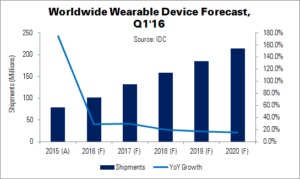Wearable shipments will grow 29% this year compared to 2015, says IDC, reaching 101.9 million units. With a CAGR of 20.3%, wearable shipments will reach 213.6 million units in 2020.
The wearables market is split between multiple types of devices, unlike smartphones, which brought many technologies together into a single product, says IDC’s Jitesh Ubrani. He added, “the market will clearly benefit from the emergence of additional form factors, like clothing and eyewear, that will deliver new capabilities and experiences.” Eyewear will focus on the business market while smart clothing will be aimed at consumers.
Cellular connectivity and applications are two factors driving the wearables market. Devices with cellular connectivity mean that users are not tethered to a smartphone. This means that owners can transmit live data on, for instance, step counts or activity to their doctor, and the user can receive context-sensitive information in return. Apps, meanwhile, increase the value and utility of wearables.
| Top Wearable Products with Shipments, Market Share and 5-Year CAGR (Millions) | |||||||
|---|---|---|---|---|---|---|---|
| Product | 2015 Shipments | 2016 Shipments (F) | 2020 Shipments (F) | 2015 Share | 2016 Share (F) | 2020 Share (F) | 2016-2020 CAGR |
| Watch | 31.9 | 41.8 | 111.3 | 40.4% | 41.0% | 52.1% | 27.8% |
| Wrist Band | 39.6 | 51.4 | 60.8 | 50.2% | 50.5% | 28.5% | 4.3% |
| Eyewear | 0.1 | 0.2 | 18.8 | 0.2% | 0.2% | 8.8% | 201.2% |
| Clothing | 0.4 | 2.2 | 15.6 | 0.6% | 2.2% | 7.3% | 62.6% |
| Others | 6.8 | 6.2 | 7.1 | 8.7% | 6.1% | 3.3% | 3.5% |
| Total | 79.0 | 101.9 | 213.6 | 100.0% | 100.0% | 100.0% | 20.3% |
| Source: IDC | |||||||
Wearables are split into different categories. Watches are gaining mainstream awareness with the release of devices like the Apple Watch. IDC expects the watch segment to increase its market share from 41% of the wearables market this year, to 52.1% in 2020. However, this will not only be smartwatches. Basic watches, with some sort of fitness/sleep tracking, will provide most of the future growth.
Wrist bands dominate the market today, and will remain influential, driven by low-cost vendors like Xiaomi and Fitbit. However, watches will challenge wrist bands as they begin to incorporate the above basic features.
A promising new market is eyewear. Microsoft’s Hololens and new Google hardware partners are projected to drive this category. The focus will initially be on enterprise use, although IDC expects some vendors to offer consumer models, too. By 2020, eyewear will account for less than 10% of wearable shipments – but more than 40% of revenue.
Traditional fashion and fitness brands are working with technology companies to produce smart clothing. Even conventional firms like Samsung and Lenovo are beginning to make inroads. IDC expects smart clothing to take a 7.3% share of the market by 2020.
Other wearables, like clip-on devices, hearables and helmets, will account for 6.1% of the market this year, falling to 3.3% by 2020. Although high growth is not expected, IDC recommends watching this space, as multiple vendors will cater to niche audiences with innovative new devices and uses.

